Gelukkig Koninginnedag from Annie Bos!
April 28, 2012
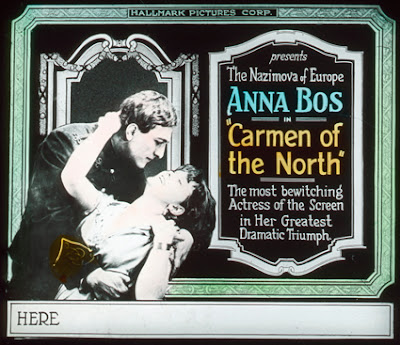
Happy Queen's Day!
We commemorate today's celebration with a slide of Annie Bos in the 1919 Dutch feature Een Carmen van het Noorden, also released in the U.S. the following year under the literally translated title A Carmen of the North.
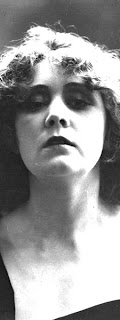
Though little-known today, Annie Bos was Netherlands first major film star. Making her first screen appearance in 1913, Bos quickly rose in fame and popularity and was sometimes referred to in Europe as "the Dutch Asta Nielsen." Interestingly, U.S. promoters apparently didn't think the nickname would resonate with American audiences and instead the slide describes her as "The Nazimova of Europe." Alas, perhaps Annie's star was not quite bright enough to shine alone and promoters felt compelled to perpetually describe her as the Dutch version of somebody else.
The decade of the 1910s proved to be the heyday of Annie Bos's popularity, particularly the years 1914-19 during which she starred in dozens of features. Her star began to fade soon after the war, appearing in only a handful of Dutch productions after 1920. In 1922 she came to the United States where she appeared under the name Anna Bosilova in her only non-Dutch film, Without Fear (1922). Afterwards she returned to the Netherlands where she made one final film appearance (Mooi Juultje van Volendam, 1925) before retiring from the screen.
The website for EYE Film Institute Netherlands provides this synopsis for Een Carmen van het Noorden:
Jozef lives in a village in Holland with his mother and his betrothed, Mareike. He is called to military service and, bidding good-bye to his sweetheart, promises to return as soon as he is mustered out. He is assigned to military police duty in a city where Carmen, a bewitching young cigarette maker, lives.
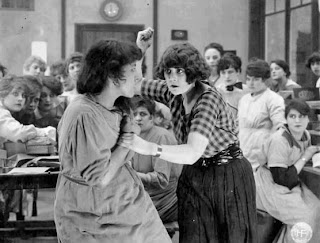
Carmen gets into a dispute with one of the factory girls and, in a burst of fury, injures her with a pair of scissors. Jozef is summoned to arrest her. He resists her coquetish glances and manages to handcuff her and put her in prison. She persists in exerting her wiles until he, madly infatuated, consents to set her free. For this he is disgraced, imprisoned and finally dishonourably discharged.
Carmen hastens to a smugglers' headquarters and here he traces her. Mareike, growing anxious because she has heard nothing from Jozef for weeks, starts out in search of him.
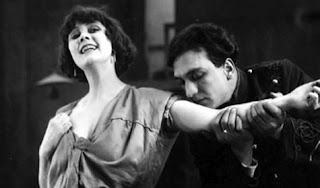
Carmen's charm has proved too strong for Jozef to resist. One night as he is jealously watching Carmen's flirtations with the military police (with whom she is detaining so that the smugglers can get over the border) Mareike comes to him, but he refuses to go home with her.
Carmen's affection for Jozef is very fleeting and she soon gives him up for Dalboni, a popular opera singer she has met in a café. Carmen and Dalboni marry. Jozef, broken down and disheartened, comes to the theatre where Dalboni is singing. He finds Carmen and pleads with her. When she laughs at him, he stabs her to death.
In his book Of Joys and Sorrows, A Filmography of Dutch Silent Fiction, Geoffery Donaldson notes the censor's reaction to the film:
In the magazine of the Dutch local censorship, Maandblaad voor de Bioscoop-Commissie (15/10/1919) [10/15/1919 to North Americans] the local censorship of Groningen declared this film unsuitable of screening to a young audience because of the easy virtues of the leading lady. The film was also banned for young audiences by local censorship of Leeuwarden (Maandblaad voor de Bioscoop-Commissie 15/1/1920) because it showed too much passion.
I had the pleasure of viewing a retrospective of Annie Bos's films at the 2007 Le Giornate del Cinema Muto in Pordenone, Italy and very much remember this title in particular. Bos had been completely unknown to me but I quickly came to appreciate the unlikely concept of Dutch diva. Clearly the Italians had not entirely cornered the market on soul-sucking love-devouring femme fatales.
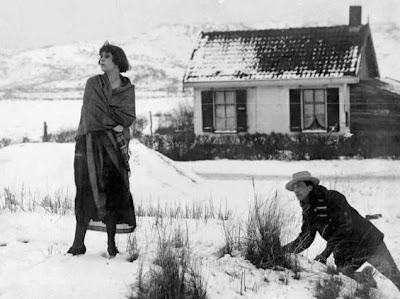
Unfortunately, the wonderfully tragic ending described in EYE's synopsis is not the version that I have seen. The surviving film print held by EYE Film Institute is the American export version which catered to American audiences by substituting a happy ending in the place of Carmen's murder. As David Robinson explains in his 2007 Giornate program notes, "In the original version of the film, Jozef goes to the theatre where Dalboni is performing Carmen, and stabs Carmen to death. The print which has survived, was a version made for American distribution, in which, after Jozef has served a two-year prison sentence, everyone enjoys a happy ending, as unmerited as unlikely."
I was especially pleased to come across this slide for A Carmen of the Northwhile scanning a friend's collection. For several years I have searched without success for Dutch coming attraction slides. Now, after cataloging over 5,000 individual slides, I have my first example of a slide featuring a Dutch film - even though it is American-produced slide. My search continues for slides actually used within Dutch cinemas, but at least this seems like a step in the right direction.
Slide for A Carmen of the North courtesy of Jessica Rosner.
